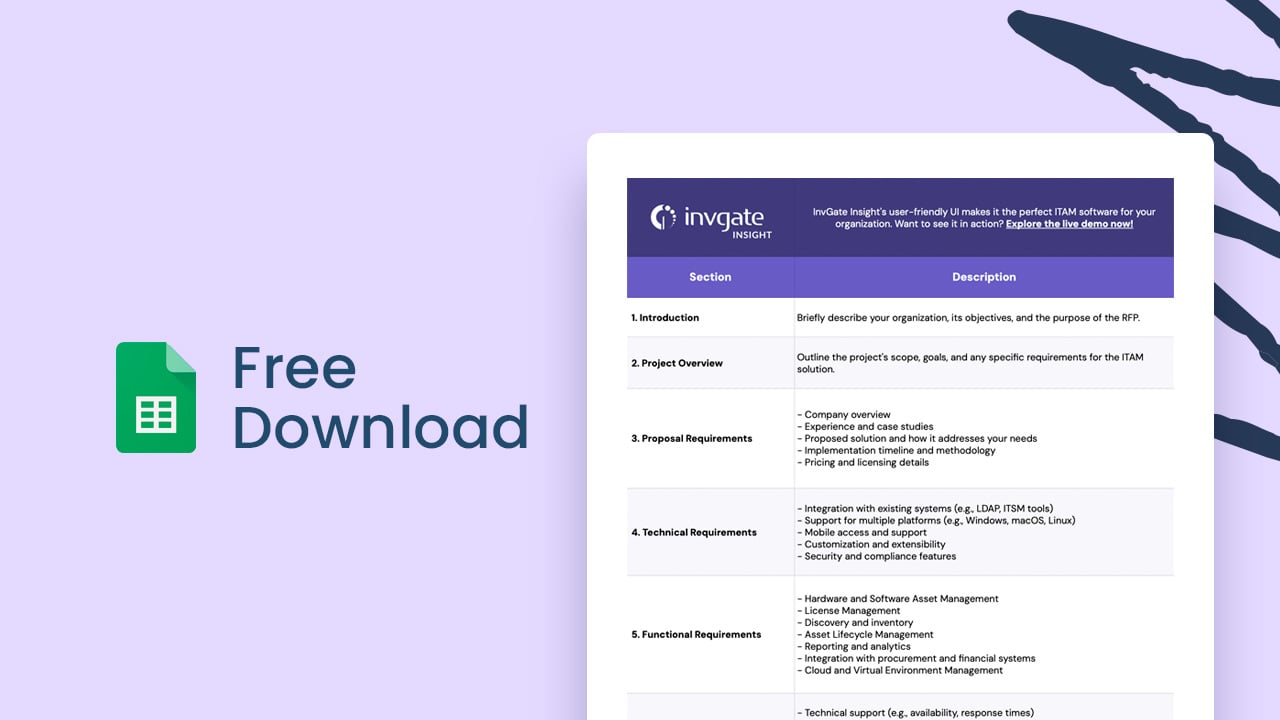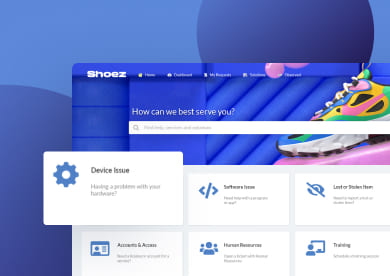Looking for an IT Service Management platform and need a fair, structured way to compare options? A Request for Proposal process structures your evaluation so you compare vendors systematically rather than getting swayed by polished sales presentations.
This guide walks through the practical decisions you'll face during your ITSM RFP process. You'll learn when an RFP makes sense versus simpler procurement approaches, how to structure your requirements for meaningful vendor responses, and realistic timelines.
We also include a free downloadable ITSM RFP template to help you get started.

What is an ITSM RFP?
An ITSM RFP (Request for Proposal) is a formal document that organizations send to potential software vendors when shopping for IT Service Management or service desk solutions. The document outlines your technical requirements, business goals, budget constraints, and evaluation criteria. Vendors respond with detailed proposals explaining how their platform meets your needs, their pricing structure, implementation timeline, and support capabilities.
Organizations use RFPs when they need to make significant software investments that will affect multiple departments. The process creates a structured framework for comparing vendors on equal footing. You'll receive standardized responses that make it easier to evaluate which platform offers the best fit for your specific situation.
An RFP makes sense when you're replacing legacy systems, consolidating multiple tools, or implementing ITSM software for the first time at scale. The formal process helps justify the investment to executives and ensures all stakeholders — from IT staff to finance teams — have input on vendor selection.
RFI, RFQ, or RFP: When to Use Each
These three procurement documents serve different purposes at different stages of your buying process. Understanding when to deploy each one saves time and gets you better results from vendors.
What's the difference between RFI, RFQ, and RFP?
- RFI (Request for Information) gathers general information about vendor capabilities and market options. Use it during early research when you're still learning what's available and defining your requirements. The responses help you understand what features are standard versus premium, which vendors specialize in your industry, and what budget range makes sense.
- RFQ (Request for Quotation) requests pricing for a specific, well-defined solution. Use it when you know exactly what you need and just want competitive quotes.
- RFP (Request for Proposal) asks vendors to propose complete solutions with detailed implementation plans, pricing, and proof of capability. Use it for complex purchases that require vendor expertise to design the right approach.
When is an RFQ enough?
An RFQ focuses purely on pricing for a specific, well-defined solution. You already know exactly what you need — now you want competing price quotes. The document lists precise specifications: 500 agent licenses, 24/7 phone support, mobile app access, and integration with Salesforce and Azure Active Directory.
RFQs work when you're replacing an existing system with minimal changes to your setup. The requirements are clear: same functionality, more seats, maybe a few new features. Vendors respond with straightforward pricing, implementation costs, and contract terms.
This approach falls short when you're exploring new capabilities or need vendor expertise to design your solution. An RFQ assumes you've already mapped out the technical architecture and know which features solve your problems.
When to start with an RFI before your ITSM RFP
An RFI serves as a discovery tool that prevents costly mistakes in your RFP process. Send one out when you lack clarity on what the ITSM market offers or when your organization hasn't fully aligned on requirements yet.
- You're new to ITSM software. An RFI educates you on standard features like automated ticket routing, knowledge base capabilities, Asset Management integration, and reporting dashboards. The responses reveal what's possible so you can set realistic expectations.
- Your technical environment is complex. Organizations running hybrid cloud infrastructures, legacy mainframes, or multiple security protocols need to understand which vendors can handle their setup. An RFI helps you identify which platforms integrate with your existing tools before you invest time in detailed proposals.
- Your budget is uncertain. RFI responses give you ballpark pricing without forcing vendors to create detailed quotes. This intel helps you build a realistic business case before requesting formal proposals.
- The market has changed significantly. If you are planning an ITSM migration and you last purchased ITSM software ten years ago, the vendor landscape has undergone significant changes. New players have emerged, established vendors have been acquired, and AI capabilities have become standard. An RFI updates your knowledge and prevents you from basing your RFP on outdated assumptions.
How to write an ITSM RFP (step by step)
In this section, we have broken down the RFP writing process. When creating such a document for your service desk or ITSM solution, you must make sure to include every feature you want and pain point you want to address.
Here are the eight main sections outlined in the template that you should incorporate into your document:
- Introduction - Provide a brief introduction to your organization, its objectives, and the purpose of the RFP. This section sets the context for potential vendors.
- Project overview - Outline the scope and goals of the project, including any specific requirements for the ITSM solution. Clearly define what you aim to achieve through the implementation or migration.
- Proposal requirements - List the information that vendors must provide in their proposals. This section should include details such as the vendor's company overview, relevant experience and case studies, their proposed solution, implementation timeline and methodology, as well as pricing and licensing details.
- Technical requirements - Detail the specific technical requirements for the ITSM solution. This section should cover aspects such as integration with existing systems (e.g., LDAP, ITAM tools), support for multiple platforms, mobile access and support, customization options, security, and compliance features.
- Functional requirements - Specify the desired ITSM features and capabilities that the solution should possess. This section may include Incident, Problem, and Change Management, Service Request and Catalog Management, Knowledge Management, reporting and analytics, self-service portal, and Service Level Management.
- Vendor support and services - Inquire about the support and services provided by the vendors. This section should cover details such as technical support availability and response times, training and documentation, implementation and customization assistance, and regular updates and upgrades.
- Evaluation criteria - Define the criteria that will be used to evaluate the proposals. This section should cover aspects like compliance with technical and functional requirements, vendor experience and reputation, implementation methodology and timeline, pricing, and Total Cost of Ownership (TCO).
- Submission details - Provide information on how vendors should submit their proposals, including the submission deadline, contact person for questions, the preferred format for proposals (e.g., PDF, Word), and submission method (e.g., email, online portal).
ITSM RFP template [Download]
After years of expertise in handling numerous RFPs for organizations worldwide, we have developed a sample that serves as an excellent starting point to create your own ITSM RFP request.
Use this ITSM RFP template to define your scope, list requirements, and standardize vendor responses.
By utilizing this guide, you can save time and effort while ensuring you include all the main points and ask the right questions to potential vendors. Download it in Word or Google Docs and customize it to your context.
ITSM requirements checklist
Confirm the solution supports the main Service Management capabilities your organization relies on. Include:
- Incident, Problem, and Change Management.
- Service request and fulfillment workflows.
- Service catalog creation and maintenance.
- Knowledge base and self-service portal.
- Configuration management and asset linkage (CMDB or equivalent).
Integrations and extensibility
Evaluate how easily the platform connects with your existing ecosystem and adapts to future needs. Consider:
- Availability of APIs and integration frameworks.
- Ability to connect with monitoring, HR, finance, or communication tools.
- Support for importing and synchronizing asset or user data.
- No-code or low-code options for building workflows and custom fields.
Reporting and KPIs
Review how the tool helps measure and communicate service performance. Look for:
- Predefined dashboards and customizable reports.
- Real-time tracking of SLAs and service health.
- Support for key ITSM metrics such as MTTR, ticket volume, backlog trends, and customer satisfaction.
- Role-based visibility for agents, managers, and executives.
Automation and AI use cases
Identify how automation and AI can improve service efficiency and accuracy. Check for:
- Automated ticket classification, assignment, and escalation.
- Workflow triggers for approvals or notifications.
- Predictive or AI-assisted suggestions for resolution.
- Chatbots or virtual agents for routine support interactions.
Governance, security, and audit
Assess how the platform protects data and maintains compliance. Include:
- Role-based access control and permission management.
- Data encryption at rest and in transit.
- Audit trails for configuration and user activity.
- Support for compliance standards and internal governance policies.
RFP basics for ITSM
The mechanics of running an ITSM RFP determine whether you end up with actionable proposals or a pile of confusing sales materials. Getting the basics right sets you up for a decision you can defend to executives and implement successfully.
How many vendors should you shortlist
A range of three to five vendors provides meaningful competition without overwhelming your evaluation team with endless comparisons.
Fewer than three vendors limits your negotiating power and reduces your exposure to different approaches. Start by identifying 8-10 potential vendors through industry research, peer recommendations, and analyst reports like Gartner or Forrester. You'll typically see 2-3 vendors self-select out because they can't meet your requirements or your project doesn't fit their target market. Adjust these numbers based on your organization's size and complexity.
How do you compare ITSM proposals fairly
Evaluate vendors based on objective, measurable, and business-relevant criteria not just on price or reputation. The goal is to identify which solution best fits your organization’s needs, maturity, and long-term goals. Here’s a structured way to approach it:
Define the criteria before reviewing proposals to avoid bias. Common categories include:
- Functional fit: How well the tool supports your ITSM processes (incident, change, problem, knowledge, request, etc.).
- Usability: How intuitive the interface is for agents and end users.
- Integration: Compatibility with your existing tools (identity management, CMDB, monitoring, etc.).
- Customization and workflow design: Flexibility to adapt processes without heavy coding.
- Reporting and analytics: Quality of dashboards, KPIs, and performance insights.
- Scalability: Ability to grow with your organization and support complex environments.
- Implementation and support: Deployment timeline, onboarding resources, vendor support model, SLAs.
- Cost structure: Licensing model, number of agents included, AI or automation add-ons, and ongoing maintenance costs.
Then, you can score each proposal section numerically. Use a 1-5 scale where 1 means the vendor doesn't meet the requirement and 5 means they exceed it with innovative capabilities.
Document your reasoning for each score. When a vendor claims their AI-powered chatbot reduces ticket volume by 40%, note whether they provided customer references, case studies, or just marketing claims. You can ask vendors to demonstrate specific scenarios, such as:
- Automating ticket routing and escalation.
- Building a self-service workflow.
- Using AI to classify or suggest resolutions.
Seeing how these are configured (and how much effort it takes) gives a truer sense of usability and adaptability.
Create different evaluator roles within your team. Have technical staff score integration and security sections while business analysts evaluate workflow capabilities and reporting features. End users should test the interface during demos and rate usability.
Watch for red flags that scoring matrices can't always catch. Vague responses to specific questions, missing pricing details, or proposals that don't address your industry requirements signal potential problems. You can also speak to existing customers in similar industries or sizes. Ask about performance, vendor responsiveness, and upgrade experiences.
Do you need separate RFPs for ITSM and ITAM
You don’t necessarily need separate RFPs for ITSM and ITAM, but it depends on your goals. If the same team manages both functions and you want a unified platform, a single RFP covering both makes sense — it encourages vendors offering integrated solutions to demonstrate how their tools work together.
However, if your organization manages assets and services separately or has distinct maturity levels, issuing two RFPs can help you evaluate specialized vendors more accurately. The key is to define a clear scope and evaluation criteria, either way, so proposals remain comparable and aligned with your operational needs.

What timeline is realistic for an ITSM RFP
A realistic ITSM RFP timeline usually spans 10 to 16 weeks, depending on the project’s complexity and stakeholder involvement. Here’s a general breakdown:
- 1–2 weeks: Define requirements, evaluation criteria, and RFP documentation.
- 3–4 weeks: Distribute the RFP and allow vendors time to prepare responses.
- 2–3 weeks: Review proposals, score them, and shortlist finalists.
- 2–3 weeks: Conduct demos, Q&A sessions, and reference checks.
- 1–2 weeks: Final evaluation, selection, and contract negotiations.
Larger organizations or those involving multiple departments may need extra time for alignment and approvals, especially if procurement policies are strict.
Practical tips and common pitfalls
When running an ITSM RFP, clarity and structure make all the difference. Each of these points can guide your process while helping you avoid common setbacks:
- Define “must-haves” early. Prioritize essential capabilities to keep vendors focused—otherwise, you’ll receive bloated proposals packed with unnecessary features.
- Align pricing assumptions. Ask vendors to quote using the same number of users, service tiers, and contract terms; if not, cost comparisons become misleading.
- Validate through a proof of concept (PoC). Testing real workflows prevents surprises during implementation, unlike relying solely on demos or sales claims.
- Keep requirements specific. Vague or high-level descriptions invite inconsistent interpretations and make scoring subjective.
- Involve a cross-functional team. Broader input reduces bias and captures operational needs; limiting the review to IT alone can miss business-critical factors.
- Assess long-term scalability. A solution that fits today’s size but can’t grow with your organization often leads to costly migrations later.

To sum up
In the realm of ITSM, it is crucial to seek a solution that not only aligns with best practices but also accommodates the maturity level of your organization. It should provide the flexibility to drive ongoing improvements in a cost-effective manner.
An ITSM RFP template serves as a valuable tool for comparing the capabilities of different vendors. It allows you to evaluate and compare proposals based on a common set of criteria, helping you make an informed decision when selecting a Service Management solution. Use the template as a starting point and customize it to suit your specific needs
To evaluate InvGate Service Management as your IT Service Management solution, book a meeting with our experts and get to know our product!















